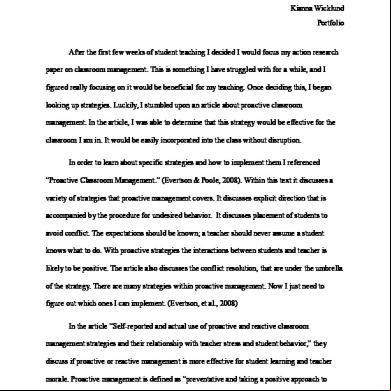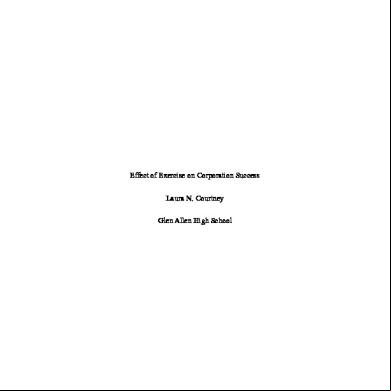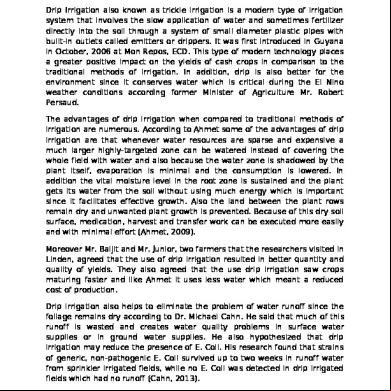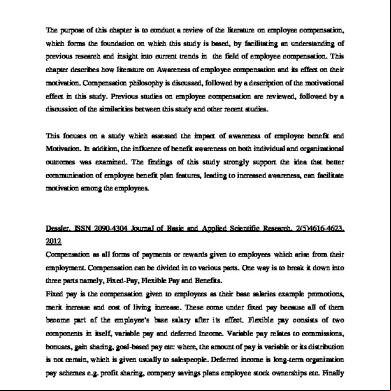Literature Review 54j4y
This document was ed by and they confirmed that they have the permission to share it. If you are author or own the copyright of this book, please report to us by using this report form. Report 2z6p3t
Overview 5o1f4z
& View Literature Review as PDF for free.
More details 6z3438
- Words: 1,377
- Pages: 6
Effects of Exercise on Corporation Success 1 Running Head: EFFECTS OF EXERCISE ON CORPORATION SUCCESS
Effect of Exercise on Corporation Success Laura N. Courtney Glen Allen High School
Effects of Exercise on Corporation Success 2 Abstract: This review examines the effect of employee and executive fitness on the success of an entire corporation or business. With the rapidly growing obesity epidemic in America, there has been an increased emphasis on exercise and healthy eating. Through many studies and surveys, researchers have found that when an executive and the employees of a company are physically fit, as determined by the American Heart Association, they are more satisfied with their jobs, are better workers, and make more money for their business. Furthermore, executives and entrepreneurs whom are frequent exercise are better liked by their employees and report greater productivity while in the office. These benefits of exercise specifically to the working class can partially be attributed to the biological benefits of exercise. Research on the effects of employee exercise is a rapidly growing field of research and upon education of the benefits of corporation fitness, employees should be educated by their employers on the benefits of exercise. Introduction: The benefits of exercise have been long researched and known my psychologists. The idea of the correlation between physical fitness and success in the office is a new concept, and the research has grown with the rise in workplaces like Google implementing company exercise programs and reporting greater employee productivity with a gym located in the office. The benefits of exercise were first self-reported, with individuals noticing that after morning exercise, their days at work were more productive and they were in better moods. Psychologists and researchers attempted, and succeeded, in quantifying the benefits of exercise for success in the workplace. Employees and their bosses are finding greater success in their jobs when exercise becomes a part of their daily schedule.
Effects of Exercise on Corporation Success 3 Defining Fitness and Exercise: The American Heart Association has changed their recommended exercise amount. Their 2005 update from their prior 1995 quota. They recommend thirty minutes of moderate intensity physical activity at last five days a week or twenty minutes of vigorous activity at least three days a week. Additionally, these can be combined and alternated, some days with moderate and others with vigorous activity. The recommendations have been made assuming that some physical activity happens during the day from walking, self-care, and cleaning (Frew & Bruning, 1988). To maximize exercise, individuals should seek to exercise in a way that promotes endurance, strength, and flexibility (Neck & Cooper, 2000). For the purposes of this paper, a fit individual is one who meets and/or exceeds the recommendations by the American Heart Association. Benefits of CEO Fitness: Andrew Johnston, a business professor at Red Rocks Community College teaches a class called Change through Challenge, where business executives spend the semester training for a full marathon and attending weekly seminar classes regarding how their training parallels their work. His class has been wildly successful because marathon training and running a marathon both require goal setting, consistency, and perseverance. of his class report back to him citing that they feel as if they can better overcome adversity in their careers after knowing they can run a marathon. The success of his class proves that the positive consequences of running can in fact help an executive have increased success in their job (Johnston, 2015). To quantify these results, Limbach and Sonnenburg researched the corporate benefits of CEOs who have successfully completed a marathon within a year of the study. They found that these “fit CEOs” were better able to moderate stress, had improved cognitive function while at work, increased
Effects of Exercise on Corporation Success 4 self-esteem, more positive behavior, and generally higher performance compared to nonmarathon running CEOs. Furthermore, fit CEOs had a higher firm value, as determined by Tobin’s Q, a higher return on assets, and more cash flow (Limbach & Sonnenburg, 2015). But the benefits of CEO fitness extend past monetary and self-benefits. Physically active CEOs and managers, as determined by the American Heart Association, had higher evaluation scores from their constituents and employees. On a scale of 1-5, the interpersonal performance and task completion was a 3.93 for physically fit leaders compared to a 3.85 for physically unfit leaders (King et al., 2014). Benefits of Employee Fitness: Employees should not dismiss exercise as something for just CEOs. Normal employees can still reap similar benefits from regular exercise. People who exercise at least three times a week have enhanced job performance in high-stress jobs. For example, real estate brokers who exercised three times a week for twelve consecutive weeks had greater commissions during and after the twelve weeks compared to those who declined participation in the study (Lovelace, Manz, & Alves, 2007). Similarly, individuals who exercise according to the standards set by the American Heart Association perform more consistently throughout the day, have a stronger heart, and are less fatigued after a long day at work (Chtourou, Hamdi, & Souissi, 2012). One of the greatest benefits of exercise is that it lowers stress levels, an essential characteristic in an effective employee. As a result of lower stress levels, employees are able to be more productive and resilient during their time at work, truly maximizing their time in the office. Although the number one excuse for lack of exercise, specifically of working Americans, is that they don’t have enough time. But, as pointed out in the Journal of Managerial Psychology, “people who say
Effects of Exercise on Corporation Success 5 they can’t find time to be fit should realize that a fitness program actually produces time” (Neck & Cooper, 2000, p. 834). Why Fitness Enhances Job Performance: The benefits of exercise have been long known and researched by both biologists and psychologists. The rationale for the increased performance in the workplace due to exercise can be explained partially by biology. For example, a positive consequence of exercise is a lower resting heart rate. This is because frequent exercisers have a higher maximum oxygen uptake and as a result can exert themselves longer without fatigue. As a result, fit employees and CEOs carry their physical resilience into the workplace, which explains the increase in task efficiency and productivity (Lovelace et al., 2007). Similarly, exercise results in a large secretion of serotonin, norepinephrine, and endorphins by the endocrine system. All of these neurotransmitters positively affect one’s mood, which explain the positive mood states after exercise and the increased satisfaction with fit CEOs (King et al., 2014) (Frew & Bruning, 1988). Conclusion: The positive benefits of exercise for working individuals discussed in this review should not be ignored. When examining the benefits of exercise from both lenses, psychological and biological, it is logical that exercise makes employees and executives more effective in the workplace. Given the recent rise in America’s obesity epidemic, corporations and businesses should highly consider physical fitness when hiring new employees and perhaps consider implementing a company-wide exercise program to encourage fitness among the entire office. This subject should become increasingly more relevant to businesses and hiring practices alike because exercise is a (sometimes) free tool to enhance performance across the entire office.
Effects of Exercise on Corporation Success 6 References Chtourou, Hamdi, and Nizar Souissi. "The effect of training at a specific time of day: a review." The Journal of Strength & Conditioning Research 26.7 (2012): 1984-2005. Frew, D. R., & Bruning, N. S. (1988). Improved Productivity and Job Satisfaction Through Employee. Hospital materiel management quarterly, 9(4), 62. King, Eden B., et al. "Waistlines and Ratings of Executives: Does Executive Status Overcome Obesity Stigma?." Human Resource Management (2014). Limbach, P., & Sonnenburg, F. (2015). Does CEO fitness matter?. Lovelace, K. J., Manz, C. C., & Alves, J. C. (2007). Work stress and leadership development: The role of self-leadership, shared leadership, physical fitness and flow in managing demands and increasing job control. Human Resource Management Review, 17(4), 374387. Johnston, A. (2015, May 20). Andrew Johnston: What is the Best Business Education? Run a Marathon. [Video file]. Retrieved from https://www.youtube.com/watch? v=oW91ATcgXVc Neck, C. P., & Cooper, K. H. (2000). The fit executive: Exercise and diet guidelines for enhancing performance. The Academy of Management Executive, 14(2), 72-83.
Effect of Exercise on Corporation Success Laura N. Courtney Glen Allen High School
Effects of Exercise on Corporation Success 2 Abstract: This review examines the effect of employee and executive fitness on the success of an entire corporation or business. With the rapidly growing obesity epidemic in America, there has been an increased emphasis on exercise and healthy eating. Through many studies and surveys, researchers have found that when an executive and the employees of a company are physically fit, as determined by the American Heart Association, they are more satisfied with their jobs, are better workers, and make more money for their business. Furthermore, executives and entrepreneurs whom are frequent exercise are better liked by their employees and report greater productivity while in the office. These benefits of exercise specifically to the working class can partially be attributed to the biological benefits of exercise. Research on the effects of employee exercise is a rapidly growing field of research and upon education of the benefits of corporation fitness, employees should be educated by their employers on the benefits of exercise. Introduction: The benefits of exercise have been long researched and known my psychologists. The idea of the correlation between physical fitness and success in the office is a new concept, and the research has grown with the rise in workplaces like Google implementing company exercise programs and reporting greater employee productivity with a gym located in the office. The benefits of exercise were first self-reported, with individuals noticing that after morning exercise, their days at work were more productive and they were in better moods. Psychologists and researchers attempted, and succeeded, in quantifying the benefits of exercise for success in the workplace. Employees and their bosses are finding greater success in their jobs when exercise becomes a part of their daily schedule.
Effects of Exercise on Corporation Success 3 Defining Fitness and Exercise: The American Heart Association has changed their recommended exercise amount. Their 2005 update from their prior 1995 quota. They recommend thirty minutes of moderate intensity physical activity at last five days a week or twenty minutes of vigorous activity at least three days a week. Additionally, these can be combined and alternated, some days with moderate and others with vigorous activity. The recommendations have been made assuming that some physical activity happens during the day from walking, self-care, and cleaning (Frew & Bruning, 1988). To maximize exercise, individuals should seek to exercise in a way that promotes endurance, strength, and flexibility (Neck & Cooper, 2000). For the purposes of this paper, a fit individual is one who meets and/or exceeds the recommendations by the American Heart Association. Benefits of CEO Fitness: Andrew Johnston, a business professor at Red Rocks Community College teaches a class called Change through Challenge, where business executives spend the semester training for a full marathon and attending weekly seminar classes regarding how their training parallels their work. His class has been wildly successful because marathon training and running a marathon both require goal setting, consistency, and perseverance. of his class report back to him citing that they feel as if they can better overcome adversity in their careers after knowing they can run a marathon. The success of his class proves that the positive consequences of running can in fact help an executive have increased success in their job (Johnston, 2015). To quantify these results, Limbach and Sonnenburg researched the corporate benefits of CEOs who have successfully completed a marathon within a year of the study. They found that these “fit CEOs” were better able to moderate stress, had improved cognitive function while at work, increased
Effects of Exercise on Corporation Success 4 self-esteem, more positive behavior, and generally higher performance compared to nonmarathon running CEOs. Furthermore, fit CEOs had a higher firm value, as determined by Tobin’s Q, a higher return on assets, and more cash flow (Limbach & Sonnenburg, 2015). But the benefits of CEO fitness extend past monetary and self-benefits. Physically active CEOs and managers, as determined by the American Heart Association, had higher evaluation scores from their constituents and employees. On a scale of 1-5, the interpersonal performance and task completion was a 3.93 for physically fit leaders compared to a 3.85 for physically unfit leaders (King et al., 2014). Benefits of Employee Fitness: Employees should not dismiss exercise as something for just CEOs. Normal employees can still reap similar benefits from regular exercise. People who exercise at least three times a week have enhanced job performance in high-stress jobs. For example, real estate brokers who exercised three times a week for twelve consecutive weeks had greater commissions during and after the twelve weeks compared to those who declined participation in the study (Lovelace, Manz, & Alves, 2007). Similarly, individuals who exercise according to the standards set by the American Heart Association perform more consistently throughout the day, have a stronger heart, and are less fatigued after a long day at work (Chtourou, Hamdi, & Souissi, 2012). One of the greatest benefits of exercise is that it lowers stress levels, an essential characteristic in an effective employee. As a result of lower stress levels, employees are able to be more productive and resilient during their time at work, truly maximizing their time in the office. Although the number one excuse for lack of exercise, specifically of working Americans, is that they don’t have enough time. But, as pointed out in the Journal of Managerial Psychology, “people who say
Effects of Exercise on Corporation Success 5 they can’t find time to be fit should realize that a fitness program actually produces time” (Neck & Cooper, 2000, p. 834). Why Fitness Enhances Job Performance: The benefits of exercise have been long known and researched by both biologists and psychologists. The rationale for the increased performance in the workplace due to exercise can be explained partially by biology. For example, a positive consequence of exercise is a lower resting heart rate. This is because frequent exercisers have a higher maximum oxygen uptake and as a result can exert themselves longer without fatigue. As a result, fit employees and CEOs carry their physical resilience into the workplace, which explains the increase in task efficiency and productivity (Lovelace et al., 2007). Similarly, exercise results in a large secretion of serotonin, norepinephrine, and endorphins by the endocrine system. All of these neurotransmitters positively affect one’s mood, which explain the positive mood states after exercise and the increased satisfaction with fit CEOs (King et al., 2014) (Frew & Bruning, 1988). Conclusion: The positive benefits of exercise for working individuals discussed in this review should not be ignored. When examining the benefits of exercise from both lenses, psychological and biological, it is logical that exercise makes employees and executives more effective in the workplace. Given the recent rise in America’s obesity epidemic, corporations and businesses should highly consider physical fitness when hiring new employees and perhaps consider implementing a company-wide exercise program to encourage fitness among the entire office. This subject should become increasingly more relevant to businesses and hiring practices alike because exercise is a (sometimes) free tool to enhance performance across the entire office.
Effects of Exercise on Corporation Success 6 References Chtourou, Hamdi, and Nizar Souissi. "The effect of training at a specific time of day: a review." The Journal of Strength & Conditioning Research 26.7 (2012): 1984-2005. Frew, D. R., & Bruning, N. S. (1988). Improved Productivity and Job Satisfaction Through Employee. Hospital materiel management quarterly, 9(4), 62. King, Eden B., et al. "Waistlines and Ratings of Executives: Does Executive Status Overcome Obesity Stigma?." Human Resource Management (2014). Limbach, P., & Sonnenburg, F. (2015). Does CEO fitness matter?. Lovelace, K. J., Manz, C. C., & Alves, J. C. (2007). Work stress and leadership development: The role of self-leadership, shared leadership, physical fitness and flow in managing demands and increasing job control. Human Resource Management Review, 17(4), 374387. Johnston, A. (2015, May 20). Andrew Johnston: What is the Best Business Education? Run a Marathon. [Video file]. Retrieved from https://www.youtube.com/watch? v=oW91ATcgXVc Neck, C. P., & Cooper, K. H. (2000). The fit executive: Exercise and diet guidelines for enhancing performance. The Academy of Management Executive, 14(2), 72-83.





